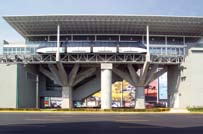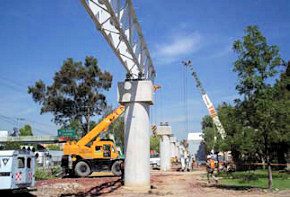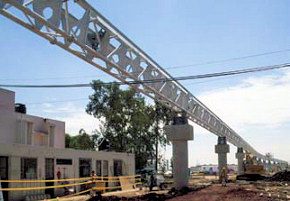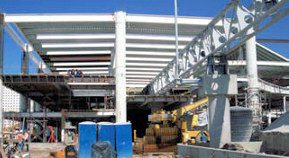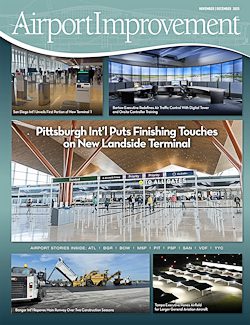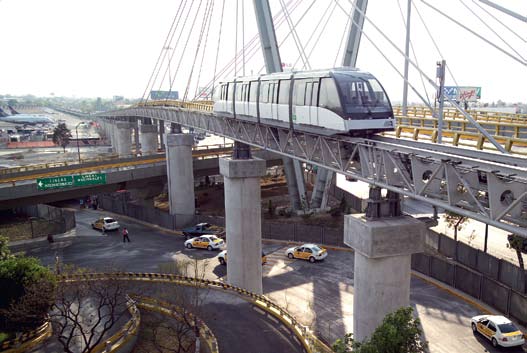
|
Mexico City Airport |
The solution proved to be a $60 million electric train capable of carrying 7,000 passengers per day. The shuttle, which began operation in January 2007, carries more than 500 passengers per hour at a speed of nearly 28 miles per hour. Travel time between the terminals is less than five minutes; stops at each end are one minute each.
One-Horse Race
Although Mexico City’s APM project generated considerable interest among shuttle transportation companies worldwide, only one company actually
|
Facts & Figures Project: Automated People Mover Location: Mexico City International Airport Airport Operator: Aeropuerto y Servicios Auxiliares (ASA) APM Manufacturer: Doppelmayr Cable Car (DCC) Construction: Ingenieros Civiles Asociados (ICA) Construction Time: 22 months Total Cost: $60 million Operation and Maintenance: $1.5 million/year APM Specs Configuration: Single track shuttle with one four-car train Guideway: Elevated steel tube truss on concrete substructure Speed: 27.9 mph Travel Time: 4 minutes, 35 seconds Stop Time: 1 minute Passenger Capacity: 26 per car, 104 per train System Capacity: 537 passengers per hour per direction |
“We expected to have more competitors in the bidding process,” says Gabriel Ibarra, director of business development for ICA. “But as companies learned about the specific issues involved, their interest diminished.”
According to Ibarra, the specific issues included “unique difficulties” regarding the engineering requirements, completion deadlines and cost considerations.
With only 22 months available for construction, ensuring that the APM would be operational by January 2007, when the new terminal opened, was a major undertaking. According to Bo Birk Pedersen, DCC’s vice president of sales, three years is a more typical timeline for constructing such a system.
“The scheduled time frame for completion of the project was very tight,” reflects Federico Dovali, assistant director of basic studies and consultancy for Aeropuerto y Servicios Auxiliares (ASA), the Mexican government agency responsible for design and operation of airport terminals throughout Mexico. “The Doppelmayr-ICA consortium fulfilled all of our requirements for a turnkey project, including basic design, construction of the infrastructure, testing and start of operations within a 22-month time frame.”
Ibarra identifies DCC’s design as a critical element. “The engineering alternative submitted by Doppelmayr was the perfect solution to the airport’s requests,” he notes.
Meeting the Challenge
The train system DCC engineered for the airport leverages the Doppelmayr Group’s 100 years of experience in cable propulsion technology. A central drive unit connected to a steel cable pulls the train from one station to the other and eliminates the need for heavy motors, gearboxes and braking systems. Lighter cars allow for a lighter infrastructure, which also cuts costs. A central station at a single terminal location powers and monitors the all-electric system.
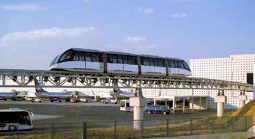
The running surface, or guideway, for the train is an elevated steel tube truss on a concrete substructure. Its relatively light, modular I-beams were prefabricated in 79- to 98-foot sections, which eliminated the need for bulky concrete structures and allowed for fast on-site installation. The guideways span up to 230 feet between support towers, which cut infrastructure costs as well as construction and installation time.
The train’s lightweight cars were manufactured by Swiss-based CWA, a wholly owned subsidiary of DCC. This provided the airport with flexibility in terms of car shape, color and interior configuration.
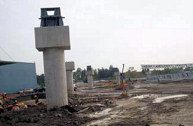 On a more macro level, the system is ISO certified and manufactured according to American Society of Civil Engineers (ASCE) standards for noise, jerk rates, ride quality, redundancies and safety measures. The train currently includes four cars, but two more can be added as need dictates. Two additional cars would increase the system’s current capacity of 537 passengers per hour per direction to 806.
On a more macro level, the system is ISO certified and manufactured according to American Society of Civil Engineers (ASCE) standards for noise, jerk rates, ride quality, redundancies and safety measures. The train currently includes four cars, but two more can be added as need dictates. Two additional cars would increase the system’s current capacity of 537 passengers per hour per direction to 806.
That Sinking Feeling
Sitting on an ancient lakebed, Mexico City is sinking at a rate of two to three inches per year, which presents obvious challenges for any major construction project. Although DCC’s relatively light steel guideways alleviated some of the engineering problems that heavier concrete support structures would have encountered, the DCC-ICA consortium had to make allowances for the variable sinking of support structures along the route.
“We developed a special tool to measure the height of the guideway relative to an established reference point,” explains DCC’s Pedersen. The height of the guideway is readjusted with a special system developed by DCC based on measurements taken every two meters. “That was a key challenge in installing this system,” notes Pedersen.
|
|
In addition to designing and installing the airport’s people mover, DCC operates and maintains the system for $1.5 million per year through a local company. Drive units are centrally located in a control room, which makes operation and maintenance easier, more efficient and less costly. Because train units are passive, they do not have to be removed from service for maintenance and spare trains are not necessary.
“It’s a low-intensity maintenance system because the operating system is centrally located,” notes Pedersen.
Fast & Green
Adding an electrically driven APM provides the airport with a number of ecological advantages – a notable initiative given Mexico City’s overall dismal rankings for air quality and pollution.
“Finding green solutions is an important part of DCC’s mission,” says Pedersen. “With self-propelled systems, you’ll find particles along the track from rubber tires, braking dust and oil spills. Our passive trains produce no carbon emissions, and electrical energy is fed back into the system during braking.”
Given the 22-month time frame for completing the project and the complex engineering challenges involved, excellent communication and project coordination between DCC and ICA were critical to the project’s success.
ICA performed all the soil mechanics studies and made engineering decisions for the infrastructure based on DCC’s technical requirements. The company also built the two terminal stations.
Francisco Castillo Ojeda, ICA construction subdirector who served as project coordinator for the construction of the new terminal and APM infrastructure, says both projects were “complex” with “engineering challenges and tight deadlines.”
Tackling the projects with the right partner, however, significantly offset the challenges. “Our relationship with DCC was excellent,” he notes. “They are a first-class company.”

